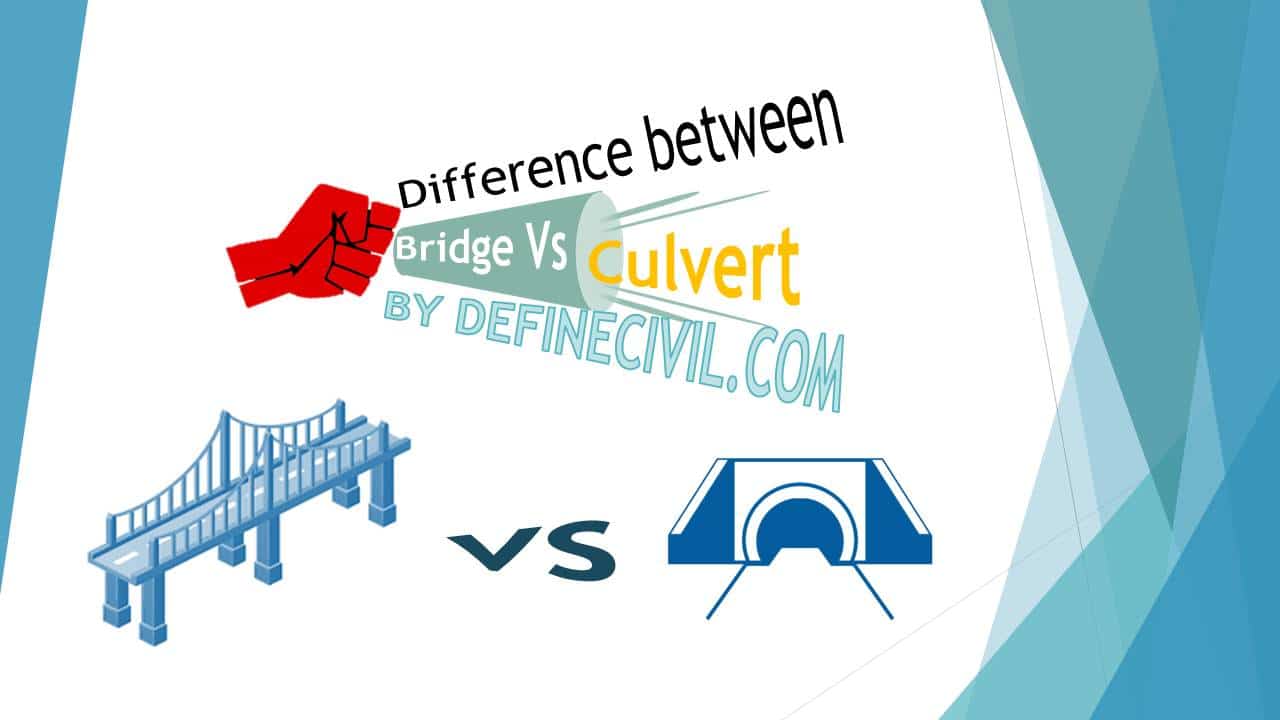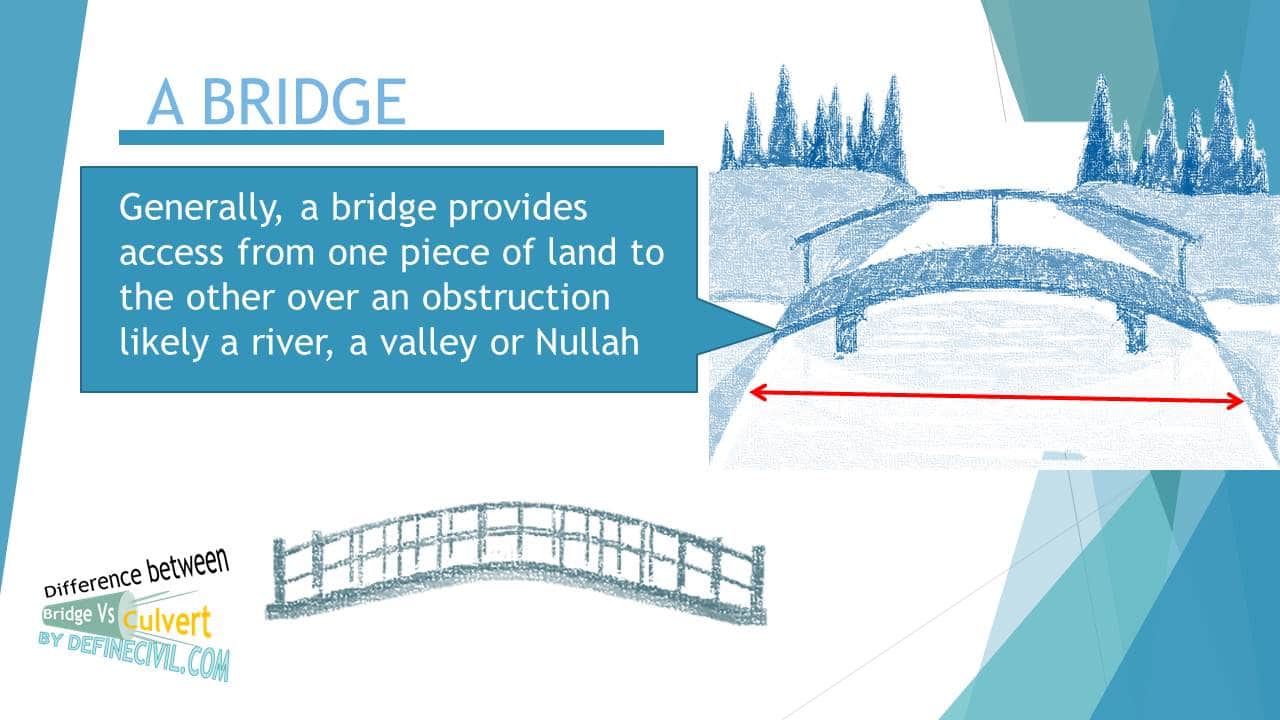Finding the difference between bridge and culvert is very important when you’re working on a highway construction project. Both bridge and culvert are important structures for the infrastructure development of any country or region.
But there’s a common confusion between these two vital structures among students as well as engineers. Both culvert and bridge span a clear space and looks similar to newbies, but there’s a clear difference between the two in their purpose as well as in their design.

So, here’s our take to let you understand the difference between culvert and bridge and how to distinguish the two by just looking. Let’s get started:

Difference between Bridge and Culvert
A bridge is a structure constructed to provide an easier rout for transportation to any area or region. Generally, a bridge provides access from one piece of land to the other over an obstruction likely a river, a valley or Nullah. It reduces the time and distance between two regions. Sometimes bridges are provided to cross one roadway or the other. In such a case it is called a bridge flyover.
A culvert is a structure that allows unobstructed passage of water under a roadway or a railway thereby preventing waterlogging, flood, and erosion.

Components
In terms of components, the two structures are far apart from each other. Culvert has comparatively simple components with easy construction. A typical box culvert includes top deck called crown, base slab called invert and the cell walls supporting the deck. 2 or 3 cell box culvert have multiple number of supporting walls at the center. The outlet of the culvert includes wing walls supporting the earth embankment and the head wing.
Parts of a typical bridge include a top deck slab supported on girders (usually I-girders) joined with diaphragms. The above components of a bridge comprise the super structure of a bridge. They are supported by bridge transom monolithic with bridge piers. The substructure of a bridge include pile cap and pile foundation.

Purpose or working
Bridge and culvert also worked differently. The culvert is a small tunnel like structure allowing passage of water under the roadway or a railway track. The bridge on the other hand is constructed for the passage of vehicles over a large body or water or physical obstruction.
Looks
If you look at the culvert you’d see it embedded or enclosed completely by soil with only outlet structure visible at the ends. So, all the load of the soil is beard by the culvert slabs and invert. In contrast to that, a bridge is an altogether different. You’ll see it open in the air with piers and deck completely visible while the abutment is supporting the soil or ground at the ends. You’d may not see the sub structure including the bridge pile cap and foundation.
Shape
Culverts are constructed in different shapes and sizes depending on the soil type and the span required. They can take any shape from semi-circular, rectangular, elliptical, or horse-shoe. Bridges on the other end are more straight and liner with no such shapes visible.
Span
One of the biggest differences between the culvert and bridge is that of the span. If you’d look at culvert, it’s typically smaller in size while for bridge, it is larger in size. For size of the culvert we use the word “length” while for bridge we use the word “span”. The length of the culvert is not more than 6 meters while bridge can span even more than 6 meters upto 120 meters.
[su_box title=”Interesting to Know” style=”glass” box_color=”#df6804″]Do you know the longest bridge of the earth is Danyang-Kunshan Grand bridge in China which is 169 kilometers in length. Find out more here: Longest Bridge[/su_box]

Foundation
A culvert only has a floor that rests directly on the excavated face of the ground. So, we can say that the culvert won’t have any deep foundation. But for bridges you need a very deep foundation that is important for the structural strength and serviceability. Most bridges have pile foundation supported on pile caps and piers.
Height
These two structures are also different in terms of height. Culverts are made less than 20 feet in height above the obstruction like a river. While a bridge can have height even more than 20 feet. The height of the structure depends on the level difference between the obstruction and the profile of the roadway or railway.
Design
The design intent of the two structures is also differentiating. The size of the culvert is based on the hydraulic data of the obstructing rive or Nullah that is called the hydraulic design of the culvert. You need to figure out the culvert rise and the culvert span depending on the field inputs. The size of the culvert is typically shown as culvert diameter. The design intent of culvert is to allow safe passage of design discharge without creating an unacceptably high headwater depth. In terms of the load, you need to consider lateral loads on the walls from the soil including the earth pressure. The load is combined with the loads from the vehicle in terms of uniformly distributed loads.
The design of the bridge is rather a complex task. Because of many components you need to go one by one from foundation, pier, transom, girders, and the top deck. Each part has a different design loads and set of steps or check to perform.
You can use culverts only on small water bodies where the discharge is limited or controlled. For large water body having a variable discharge with intermittent floods every season, bridge is always recommended.
Construction
The construction of culvert is simpler and a low-budget task. It require less time and labor for construction. Some precast culverts can be constructed even in less than a day. Precast culvert comprises of precast culvert sections that are made in a factory and are taken to the field after finishing. There at the field they are joined together to form a complete structure.
Construction of bridge, like a structure, is a complex and difficult job to undertake. It takes much more time and effort plus you need more manpower. The budge required for the bridge is also substantial.
Design intent for traffic passage
A culvert is a more accommodating structure that can be designed to allow passage of vehicle both under and over the deck / floor. In case of bridge, the only way for the traffic is through the deck i.e. above the deck.
The Bottom Line
So, I’ve tried to explain all the difference between bridge and culvert. I hope it has helped. Please don’t forget to share this useful resource to your friends. Don’t forget to return with even more interesting and useful content here all about civil engineering.



















